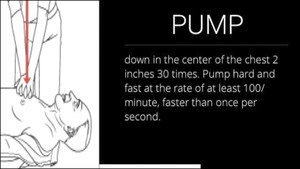Ubiquitous Computing Course @ UCSD
11.2013, One week hackathon
Role - User Researcher, Interaction Designer, Visual Designer
Tools - Paper & pencil, Illustrator, Photoshop, Axure, iMovie
Partners - Team of 2 Developers and 3 UX Designers
Discover the Right Problem
Contextual Interviewing
Brainstorming useful purposes for the Google Glass led to the problem space of emergency medical aid. My team was able to conduct a few interviews of medical professionals in order to gain better insight on the issues and needs surrounding CPR.
PROBLEM - Emergency situations requiring CPR could happen at anytime. People that are not prepared to perform in high-stress situations like that could lead to uninformed or improper techniques of CPR which lead to even more dangerous health-related situations.
Design the Right Solution
Brainstorming
Knowing the technological capabilities we could leverage with the Google Glass, my team brainstormed on a potential solution that would walk a user through the steps of CPR in real time, ensuring that the count and pace is in proper range.
Our main user is anyone with life support training that doesn't practice these skills regularly and would need a reinforcement when responding to an emergency, i.e. life guards, airplane staff, teachers, etc.
SOLUTION - Provide live feedback to assist in an emergency situation by tracking the movements of the person performing CPR utilizing technology afforded by the Google Glass.
Prototyping
We white-boarded some lo-fi workflows, then translated it into a mid-fidelity mockup in Axure (as pictured below). I also worked on the logo design using Illustrator.




Part of our final deliverable was an informational video created through iMovie, which includes:
- A walkthrough of the interface,
- An example situation where this app would be used,
- An explanation of the importance and limitations of this app with Dr. Zia Agha.
Future Considerations
Outside of the hack-a-thon scope, I would want to do a concept validation on our prototype.


